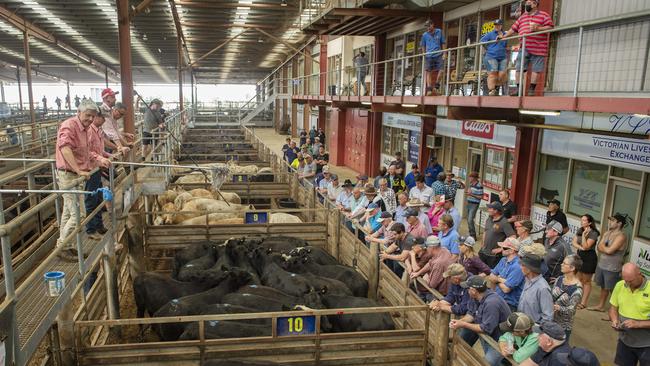Pakenham closure leads to animal reshuffle
The closure of the Pakenham Livestock Exchange this week poses the challenge of how 100,000 cattle will be scattered across other selling centres and methods.
The closure of the Pakenham Livestock Exchange this week exposes gaps in the saleyard system and poses the challenge of how 100,000 cattle will be scattered across other selling centres and methods.
There is a vast stretch of country between Koonwarra (the main weekly cattle market, Leongatha, in South Gippsland which will take over from Pakenham) to central and northern Victoria where the next significant weekly sales are located.
To pitch a scenario. There was a lot of cattle from the Kinglake, Kilmore to Kyneton area that were directed to the weekly Pakenham sale because it could handle anything, from bullocks and cows to trade cattle and lighter stores – usually with a fairly reliable following of buyers to keep a certain amount of honesty in the result.
The main choices these farmers now have are Koonwarra (more transport costs), Shepparton in the Goulburn Valley, Barnawartha near Wodonga, Echuca and Ballarat.
To look at some of these options. Shepparton is known as a fairly strong cow market but its trade cattle section is questionable, having been eroded in recent years by fewer vealers off irrigation and by commission buyers holding multiple orders that eroded buying depth for trade steers and heifers.
A lot of the best trade cattle out of the Goulburn Valley are now redirected to the Echuca saleyards which has a solid following of trade buyers but is a fortnightly sale and its export run can sometimes be lacking.
The Ballarat prime sale is also fortnightly and usually has fewer than 500 cattle, often resulting in a small band of buyers who tend to bargain hunt through the yarding which, in the words of one agent recently, is mainly an outlet for animals that don’t fit into the quality/number/breeding requirements of the big Ballarat store markets.
Different saleyards have different strengths and weaknesses and buying groups, which is not often discussed until an event like the closure of Pakenham forces a reshuffle of animals.
Finding a saleyard that has buying support for a range of different weights and grades of cattle is not easy, and it is one of the key challenges facing producers and agents affected by the shutdown of Pakenham.

A significant part of the catchment area that fed cattle into Pakenham has smaller scale properties with smaller herds, often resulting in a mixed turn-off.
The description by an agent this week was a farm running 25 cows and maybe producing a 14 head steer cohort and “from that you’ll have two big steers, two small steers and a few in-between ones to deal with”.
Which segways into another issue from the closure of Pakenham – store markets.
There are more store options in closer vicinity, including Yea, Euroa, Kyneton and Ballarat – plus Leongatha and the fortnightly store markets at Barnawartha and Mortlake potentially.
But there are also restrictions on capacity – and a lot of politics at play.
The Leongatha store markets have been running at close to capacity, and in early May it got to the point where the Victorian Livestock Exchange threatened to lock gates and turn trucks around if agents themselves didn’t work together to reduce numbers, according to correspondence seen by The Weekly Times.
That particular May sale had an early draw of around 7000 cattle: “It is physically impossible for the VLE to hold this amount of cattle. Agriculture Victoria has already firmly pointed out this fact to me and have indicated they will be attending our store sales to check on animal welfare,” a letter from VLE stated.
“The number needs to be very close or below 6000. Agents will need to collectively withdraw cattle from the sale or the VLE will place security on the gate and when we have reached 6000 head the gates will be locked and trucks turned around.”
Such drama was avoided with numbers for that May sale reducing. But other centres like Ballarat and Mortlake also have capacity limits and it is not always possible for outside entries to get space, particularly for odd lots.
Selling centres like Yea and Euroa are reportedly concerned about mixed quality store cattle being directed into their monthly markets, as they have built a trading reputation on lines of quality bred cattle, mainly Angus.
The Weekly Times understands there have been approaches by some South Gippsland agents to Yea in regards to having a regular selling spot alongside Nutrien and Elders, but details are still being discussed.
Where cattle scatter following the final prime and store markets at Pakenham this week will unfold over time.
Nutrien Kilmore agent Peter Linehan said there was likely to be a range of different selling options used.
“It will be challenging and as agents we might have to work together more to try and build consignments of smaller lots of cattle into full truck loads to make transport more efficient, while some of the bigger lines of finished cattle could end up being sold direct,” Mr Linehan said.
Brendan Carey, manager of the Shepparton saleyards, said they expect an extra 100 cattle plus to be directed into their regular Tuesday prime market, and he could see the potential to put a regular store sale on the Shepparton roster.
Kyneton agent Kieran McGrath said store cattle numbers at Kyneton had started to lift this year as people had changed selling outlets ahead of Pakenham being closed.
The shake-out of cattle could be wide and interesting to watch unfold.




